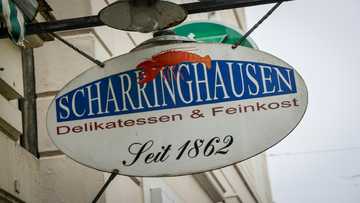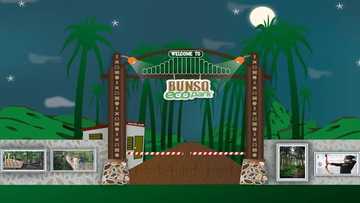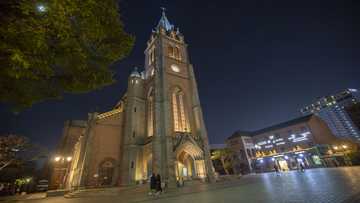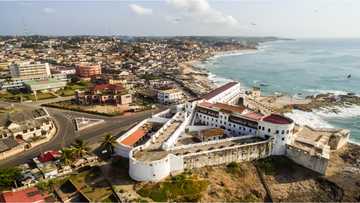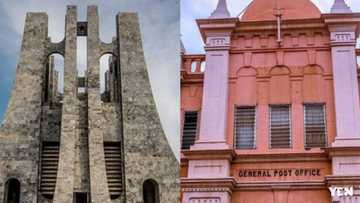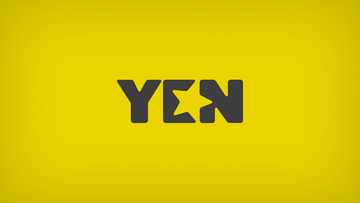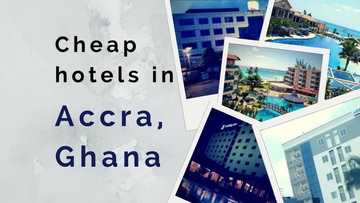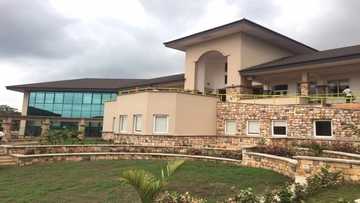List of cities in Austria, their size and population
Austria is a beautiful country with spectacular mountainous sceneries, great architecture, and many important cities. It has 9 states with each state having one or more cities that join to make up to make the list of cities in Austria. These states in Austria include Vienna, Styria, Upper Austria, Salzburg, Tyrol, Carinthia, Upper Austria, Lower Austria, and Vorarlberg.

Source: UGC
List of cities in Austria
The list of names of cities in Austria below is arranged in descending order, from the most highly populated to the least populated. Vienna tops the list of biggest cities in Austria, being the only city with a population of over 1 million. The next five cities of Graz, Linz, Salzburg, Innsbruck, and Klagenfurt follow in the list of biggest cities in Austria with population of over 100,000.
1. Vienna

Source: UGC
Vienna is the capital of Austria and it tops the list of popular cities in Austria. It is located along the right bank of Danube River, and is protected by the Vienna hills, enjoying a fair climate with an average temperature of 10 degrees Celsius and low rainfall. Vienna has a population of about 1,889,083 million. With inclusion of the urban conglomerate, the population goes up to 2.6 million, covering an area of 414.65 sq. km. It has renowned architecture and its skyline is dominated by the Spire of St. Stephen cathedral. Vienna is famous for cultural events, coffee houses, imperial sites, Viennese charm and cozy wine taverns. It has several other beautiful buildings including Schonbrunn palace with baroque formality, one of the world’s leading opera houses - Staatsoper, Hofburg Imperial Palace, The Parliament building, Karlskirche - one of Vienna’s greatest churches, and The Spanish riding school that trains Lipizzan horses. Tourists all over the world flock here and enjoy riding on traditional fiacre and two-horse carriages.
It has 23 districts. More than half of Austria’s goods are produced here and almost half of its customers goods. Transport system is well developed, there being two railway stations namely West and Main railway stations. There is also Vienna International airport – Schwechat. It is governed by mayors and two deputies and has the highest number of high school and university graduates.
2. Graz

Source: UGC
Graz is the second largest city with a population of 352,021 as at 1 January 2018 and an area of 127.56 sq.km. It is the capital of Steiermark state. Graz means "a small fortress", a sign that there existed such a feature in the past. It is known as the best preserved city center among all city centers in Central Europe and also in the list of popular cities in Austria. It lies between Styrian Alps and Grazerfeld basin, on the Mur River. Most notable buildings include UNESCO world cultural heritage site and Renaissance Landhaus. It has four universities including Graz University and University of music and dramatic arts.
The city is also an industrial and railway center with iron and steel works as well as manufacture of machinery, paper, textile and chemicals. There is also trade in grains and cereals. Tourism is also rampant. Other must see attractions in this area include the Schlossberg/ castle mountain that offers views over the medieval roof-scape, The Armory, where historic armors and weapons are preserved, The Eggenberg Palace designed by Governor von Eggenberg, where you will find 365 windows, 31 rooms on every floor, 24 state rooms, 54 doors and 4 corner towers, representing the days, hours, weeks and seasons of the year. Lastly we have the iconic Kunthaus Graz that features exhibitions on international and contemporary art.
3. Linz

Source: UGC
Linz is the third largest city with a population of 204,846 and 789,811 in the greater Linz conurbation and an area of 96.048 sq. km. It is the capital of Bundesland and also lies along the Danube River, west of Vienna. It is known for Linzer Torte, the oldest lake in the world. Ars Electronica is a fascinating science museum found here, where you’ll find information on space and the digital world. Linz hosts "the Klangwolke", a modern traditional music and light show held each September. The Lenton Kunstmuseum is a modern art hub with striking sculptures. Historic buildings are found here including the old castle and St. Martin’s church. Linz has been a trade center with the manufacture of texture, glass, beverages, and more. Many people are employed here and work in public administration.
4. Salzburg

Source: UGC
Salzburg is the fourth largest city in Austria and the capital of North Central Austria with a population of 152,367 and an area of 65.678 sq. km. It is located on a level basin on both sides of Sal Zach River near the Alps and the German border. Salzburg, whose name means "salt fortress" is one of the most beautiful cities and it follows Vienna in the list of popular cities in Austria, due to its alpine landscape and architectural richness. It is the birthplace of Mozart whose house is preserved as a museum and also the site of internationally recognized annual Salzburg festival. It is the northwestern rail and road junction to Austria and has an international airport at Maxglan. Famous buildings in the city include Fortress Hohensalzburg and the famous Café Tomaseli, the Baroque Domquartier and Burgerwehr medieval city wall. Manufactures include that textile, leather, musical instruments and hardware.
5. Innsbruck

Source: UGC
Innsbruck, translated as "bridge over the Inn", is a popular winter sports destination known for its modern architecture. It is also in the list of popular cities in Austria. It is the capital of Tyrol, Western Austria with a population of 130,894 as at 1 January 2016 and an area of 104.91 sq. km. Found at the junction of the Great trade routes from Italy to Germany via the Brenner Pass and from Switzerland and Western Europe, it is an old town with famous buildings such as the Furstenberg which has a balcony with a gilded copper roof. Others are the Court church containing the mausoleum dedicated to Maximillian 1 and the tombs of Hofer and other Tyrolean heroes. There are also major museums such as Ferdinandeum and the Tyrolean folk art museum. It is a rail and market center with wood and metal working as well as manufacture of textiles, shoes, beer, and musical instruments. Production of electrical equipment and electronics also takes place.
6. Klagenfurt

Source: UGC
Klagenfurt is the 6th largest city with a population of 100,316 as at 1 January 2018 and an area of 120.03 sq. km and is the capital of Carinthia in southern Austria. It lies on the East of Worther Lake along the Glan River, and North of the Karawanken Mountains. Notable landmarks include the dragon fountain which has Lindwurm, a winged dragon. It is the site of the state museum with museums such as the Diocesan museum and a state art gallery. Klagenfurt is a popular vacation destination with mountains North and South, parks and stately homes and castles. It hosts Alstatdzauber or "The Magic of The Old City" Festival in summer. Industries include metal, food and chemical industries, tobacco and electrical appliances. Most of the working population is in the public sector.
7. Villach
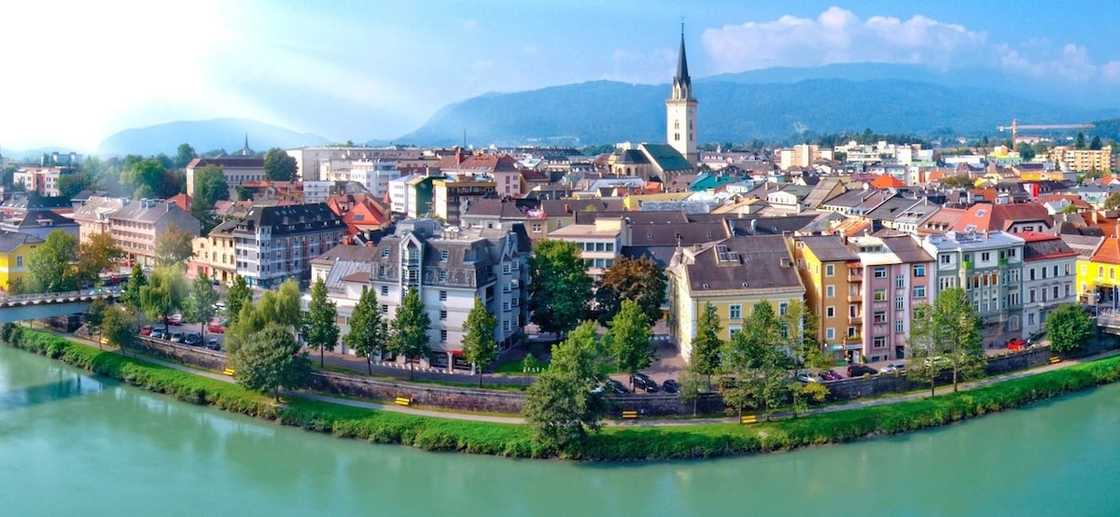
Source: UGC
Villach had a population of 61,887 as of 1 January 2018 with an area of 134.89 sq. km and is found on the Drau River, east foot of Villacher Alps, west of Klagenfurt. It is Carinthia’s second largest town. Sites worth seeing include Villacher Farhzeugmuseum, Museum der Stadt Villach for the city’s history, Landskron Castle which is on top of a 676m high hill where you can dine as you see enjoy the beautiful view of the valley of the river Drau, its lakes and the Slovenian Alps. There is also the Falconry in Landskron castle where one can enjoy watching eagles and other birds fly over their heads, Parish church of St. Jacob, Krimmler waterfall, Thermen resort and Museum of dolls made by famous artists, for all lovers of dolls. It’s the commercial center of Karten and its main railway junction. It is a tourist center, a regional market and service center for the rural hinterland. Goods manufactured include cellulose, wood products, machinery, electronics and electronic products just to name a few. Breweries and food processing plants are also available.
8. Wels
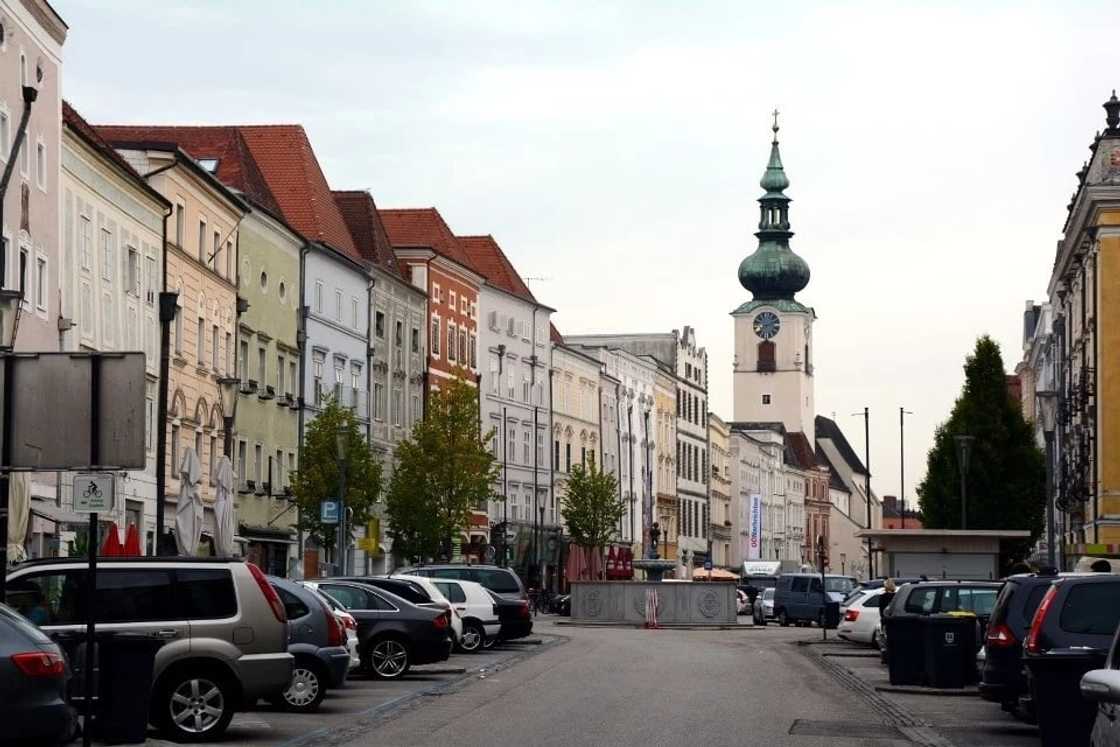
Source: UGC
Population is approximately 60,000, being at 60,399 in June 2016 and covering an area of 45.92 sq. km. It lies southwest of Linz, along the Traun River at the foothills of the Eastern Alps. Splendid sites include the River Traun cycling route, The Wels zoo where you’ll get to see wild cats, deer, donkeys and more as well feed some of them. There is also the Kalkalpen national park, Marienwarte tower, Ledererturm tower, the Burg Wels museum which features over 100 years of history, the town hall, the late Cothic parish church, and the former imperial castle where Maximillian 1 died in 1519. The city manufactures agricultural machinery, building materials textiles, foodstuff and pharmaceuticals. It is a wholesale and retail trade center, a railway junction and a cattle and grain market.
9. Sankt Polten

Source: UGC
Sankt Polten is the capital of Niederosterreich lower Austria with a population of 54,649 as of 1 January 2018 and an area of 108.48 sq. km. Sankt Polten lies along the Traisen River, west of Vienna between the foothills of the alps and Danube river. Sankt Polten's unique feature is the hypermodern government district neighbored by the modern cultural district, the place for renowned musicians and dance companies regular performances. Sankt Polten has several delightful old town squares such as Riemerplatz and Herrenplatz. Other Landmarks include the Romanesque cathedral and Renaissance town hall. The episcopal palace and the Franciscan church. It is a rail junction, market center and manufacturing city.
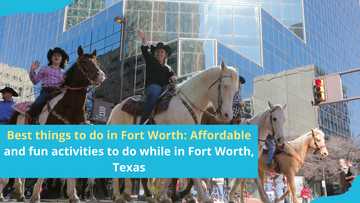
Read also
20 best things to do in Fort Worth: Affordable and fun activities to do while in Fort Worth, Texas
10. Dornbirn

Source: UGC
Dornbin is the largest city in Vorarlberg and the 10th largest city in the list of cities in Austria, located at the foot of the Karren Mountain and bordering Switzerland, Germany and Liechtenstein. The Dornbirner Ach River flows through it to Lake Constance. It had a population of 49,276 as at 1 January 2018 with an area of 120.97 sq. km. It has a railway station that connects trains from west to east Austria as well as small airport near Hohenems. Some features to explore include the Karren Dornbirn Mountain, Inatura Natural History Museum which features exhibits of natural history, Rappenlochschlucht with trailers and waterfalls, the Rolls Royce museum, and the Red House dating back to the 1600s.
11. Wiener Neustadt

Source: UGC
Wiener Neustadt lies near the Leitha River south of Vienna, in North Eastern Austria. It had a population of 44,820 as at 1 January 2018, with an area of 60.93 sq. km. It hosts the Reckturm museum, the much-restored 13th century cathedral, the town museum, 13th century castle where Maximilian 1 was born and is entombed and the Neukloster with the former Dominican church. It is the site of the world’s oldest military academies, The Theresian Academy established by Maria Teresa in 1752 to train officers from the Austrian army.

Read also
15+ fun things to do in Cincinnati: Activities and attraction sites to make your stay worthwhile
12. Steyr

Source: UGC
It is 12th most sizeable city in Austria. The city had a population of 38,347 as at 14th June 2016 and has an area of 25.56 sq.km. It is situated south of Lynz at the confluence of the Enns and Steyr rivers. The local town museum, Heimatmuseum has all the city’s history you need to know. It hosts the parish church, the Rococo town hall and many medieval houses including Bummerlhaus, a hospital in the Steyrdorf suburb dating 1305 and the Baroque castle with a rich art gallery and an extensive park. In the Museum Industrielle Arbeitswelt, one can explore the industrial heritage of Steyr. It is an iron and steel center with many manufactures including trucks, tractors, ball bearings and other machiney. It is also a center for trade and services for the nearby rural areas.
13. Feldkirch

Source: UGC
Feldkirch is a medieval city in the western Australian city of Vorarlberg with a population of 33,420 with an area of 34.35 sq. km. It is located on the border to Liechtenstein and Switzerland, in a beautiful place where three valleys meet including the Rhein valley. It is the most well preserved of all Vorarlberg cities. Worthy sites include the Schattenburg Castle with a local history museum and restaurants inside, St. Nicholas Cathedral which dates to the 13th century. Vorarlberg site of music conservation, The ruins at Tosters Castle, Church of St. Cornelius, and Johanniterkirche, a site for contemporary art installation pieces just to name a few.
14. Bregenz

Source: UGC
The city has a population of 29,086 and an area of 29.51 sq. km. Bregenz is the capital of Vorarlberg and is found on the shores of Lake Constance. It is famous for the annual summer music festival Bregenzer Festspiele and dance festival Gregenzer Spring. Its main feature in the town is the medieval St. Martins tower with a 16th century onion/shaped dome. There is also the Gothic Parish church of St. Gall and Herz- Jesu parish church.
READ ALSO: List of East African countries and their capitals
15. Klosterneuberg

Source: UGC
It is found in Tulln district in Lower Austria and hosted around 26,750 people by January 2016. Klosterneuberg covers an area of 76.2 sq.km. It is located on the Danube North of Vienna. It has various military buildings and former stores which are planned to be developed into a 12 hectare new quarter of the town by 2030. Klosterneuberg is also known for wine growing with numerous taverns and esteemed vintners. It also hosts the Essl museum of contemporary art. Historic monastery and town walls.
16. Baden

Source: UGC
It is located at the mouth of the Schwechat River in the Vienna woods. Schwechat has an area of 26.89sq.km and had a population of 25,692 as at January 2016. The Iron Gate is the highest pint in the area. Sites include the HJeiligenkreuz’s Romanesque which served as a burial place for members of the Babenberg family. There is also the Rauheneck and Rauhenstein castle. A composer, Ludwig Van Beethoven’s residences form local tourist spots. Mayerling, a hunting lodge was the site of Crown Prince Rudolf’s murder case. Baden also boasts pf a city theater, parks and casinos.
17. Leoben

Source: UGC
It is a Styrian city in Austria central located on the Mur River. Leoben has an area of 107.74 sq.km and had a population of about 25,341 as of 1 January 2016. It is known as the gateway to the Styrian iron road. It hosts the 13th century main square which features the Hackl house .Another notable features are the city parish church, St. Francis Xavier considered one of the most significant Jesuit churches in Austria. Cultural events include Congress Leoben classical concerts, productions of the summer Philharmonic in July and guest and local productions in the Austria theatre.
18. Wolfsberg

Source: UGC
It is a big city by the Aller River named after a castle on its hill side in the 13th century. It has a population of 25,045 as at January 2016 and an area of 278.63 sq.km. Wolfsberg is also known as "the Volkswagen city" as this is where Volkswagen was birthed. Hitler was the brain behind this. The factory that was to produce this car was set up in this city. 3600 cars a day are made at Volkswagen Werke. There is also the museum of Wolsburg where car lovers can visit, that hosts German cars such as Wanderer and Porsche just to mention a few. There is also the Schloss Wolfsburg which has the municipal art gallery, the Scene Alt-Wolfsburg agricultural museum and for local art and culture, there’s Wolfsburg Klieverburg where you’ll find the theatre, the planetarium and the congress park.
19. Krems an der Donau

Source: UGC
Krems an der Donauhas a population of 24,610 and an area of 51. 61sq. km. It is found in North Eastern Austria at the confluence of Danube and Krems rivers. Its remaining medieval fortifications include the Steiner gate, the Pulverturm and The Gozzoburg. Krems is an old wine producing town and the home of several well-known wineries. Austrian and foreign winners congregate in the city in the fall at harvest time.
20. Amstetten

Source: UGC
Amstetten had a population of about 23,500 as at 1 January 2016. Amstetten which is situated between Linz and Vienna and lies on River Ybbs and Url near the Danube River has an area of about 52.2 sq. km. Amstetten holds a series of weeks annually dedicated to culture known as the Kurturwochen which includes local drama, storytelling, lectures and exhibitions. There is also the Musical summer Amstetten done in summer hosting amateur and professional entertainers. Sights include the Amstetten Mauer hospital chapel and Naturbad, the indoor and outdoor swimming pool with a sauna and a slide.
21. Spittal

Source: UGC
It is located in the western part in state of Carinthia. Spittal is found on the southern slopes of the Gurktal Alps between Lurnfeld basin and the lower Drava valley. It had a population of 15,305 as at January 2016 and an area of 48.51 sq.km. It hosts one of the most important castles in Austria, the Schloss Porcia erected by the Counts of Salamanca- Ortenburg. They also rebuilt the Spittal hospital and the late Gothic Catholic church of St. Mary’s Annunciation. Today the palace hosts annual theatrical comedies as well as being a museum of local history. In Molzbichl village east of the city are the remains of Carinthia’s first monastery and a small museum showing artefacts of Carolingian origin.
22. Bludenz

Source: UGC
The city has an estimated population of 14,539 and an area of 30.0 sq.km. It is located on the Ill River and surrounded by Bregenz Forest Mountain in the North and in the South by Ratikon and Silvretta ranges. It is a popular biking and hiking resort. It is home to companies Mondelez International which produces milk chocolate and Forhenburgr which produces beer. There are various churches and castles in the city including the Castle of Gayenfohen where Bludenz district headquarters are situated.
23. Feldkirchen
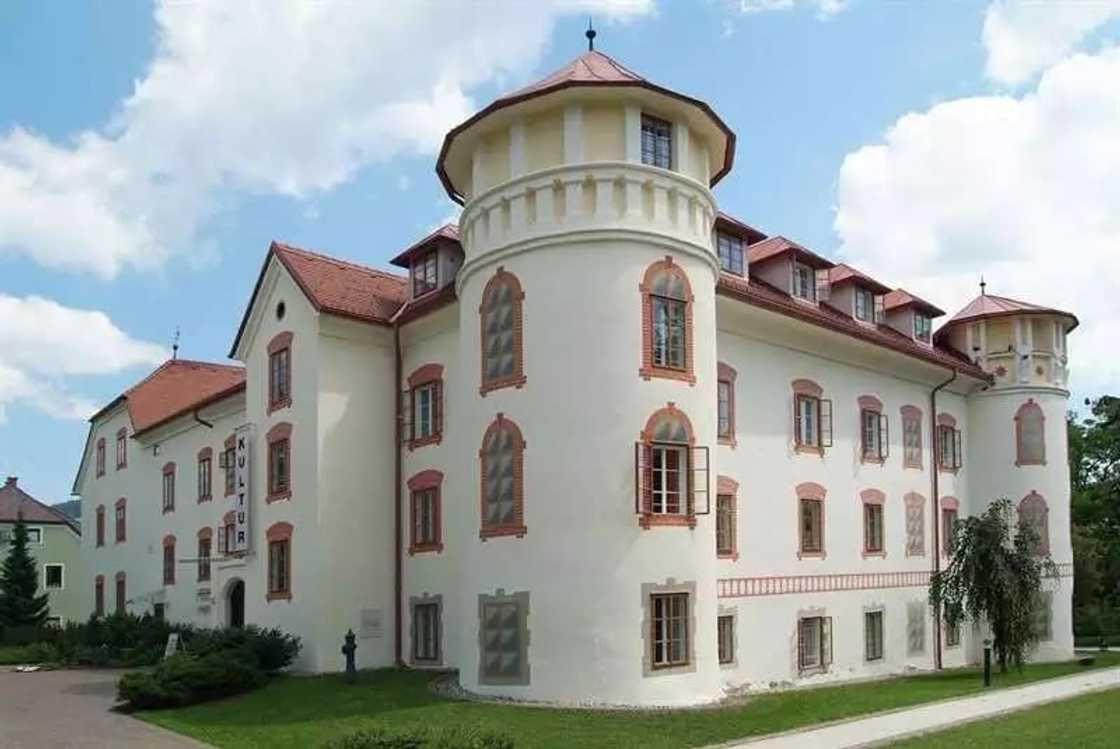
Source: UGC
Feldkirchen is a city in Carinthia with approximately 14.300 residents with an area of 77.49 sq. km. It is centrally located within the state of Carinthia hence not a popular place with tourists. It however has several attractions including the most important Bamberger Amthof which was used as an administrative headquarter for civil servants from Bamberg. Other attractions include the main parish church Stadtpfarrkirche Maria, church of St. Michael, Schloss Dietrichstein, the market square, the Rathaus and beautiful town houses.
24. Eisenstadt

Source: UGC
Eisenstadt is the capital of Burgenland with a population of 14,241 as at 1 January 2016, and an area of 42.91 sq. km. One name, Joseph Haydn is predominant here as he spent forty years as music director in service of Esterhazy Princes. Esterhazy palace is the venue for concerts by renowned artists. Other sites include the Calvary Mountain, Martins Dom / St. Martins Cathedral and The Gloriette. The districts of Kleinhoflein and St. Georgen have popular wine taverns.
25. Schwaz

Source: UGC
Schwaz is a city in Tyrol state, located in the lower Inn valley at the foot of Kellerjoch and Eiblschrofen Mountain. It has a population of approximately 13,444 as at 1 January 2016, covering an area of 20.17 sq. km. Large industrial companies including Tyrolit for abrasive production, Adler Lacke that produces coating systems and DAKA a regional waste management company. Notable sites include the Schwaz parish church, the silver mine of Schwaz, and museum der Voelker with great collection of artwork.
26. Worgl

Source: UGC
Worgl is a city in Tyrol state in Kufstein district with a population of 13,048 as at 2015, and an area of 19.68sq.km. It is located at the intersection of Brixental valley, the Sollandl area, the wild valley of Wildschonau and the Inntal valley. It has an emblem separated into three parts - red, signifying the destruction of fortified castle, gold rings for the merging of Kufstein and Rattenberg to Worgl municipality and wings stand for economic boom. Notable sites are the excavations that are evidence of trade and a settlement dating back to the Roman times. The area hosts the Water Adventure World, the largest water world in the surrounding. One of the largest sauna cabins in the world, Circus Maximus sauna is part of this facility. There are also several shopping delights such as the Bahnhofstrasse Street, the second largest mall in Tyrol.
27. Leonding
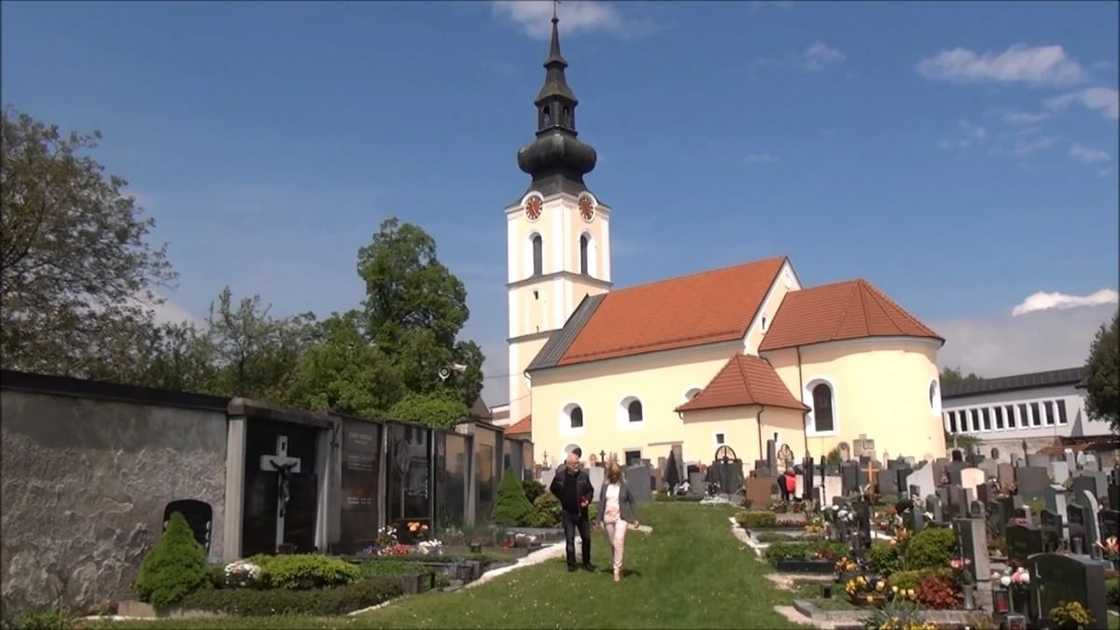
Source: UGC
It is found in Upper Austria, South West of Linz. Leonding covers an area of 24.05 sq. km and has a population of about 27,393. Leonding borders river Danube in the North. It is the most populous city in Linz- Land district and the fourth most populous city in Upper Austria state. Its beautiful Alps view makes it a preferred living place by the upper social class. Leonding’s proximity to a good transport connection like the West Railway Westautobahn attracts companies like Rosenbauer and Neuson. Adolf Hitler attended school here, and his parents and brother were buried here.
28. Traun

Source: UGC
It is located in the North bank of river Traun and it borders Linz to the East. Traun is the 5th largest city in Upper Austria covering an area of 15.49 sq. km. It has a population of 24,477. Traun has many educational institutions and is consequently known as the school city. It has 11 kindergartens, 4 primary schools, 3 secondary schools and high schools, 2 institutions for adult education and 1 music school. It has more than 1200 companies and has employed 11000 employees. Traun has two railway stations and a motorway Conner close to Linz Airport.
29. Lustenau

Source: UGC
It is located in Vorarlberg state Dornbirn district and lies on the River Thine which forms a border with Switzerland. It is the 4th largest town in Vorarlberg with an area of 22.55 sq.km and a population of 22, 214 as at 1 January 2016. Lustenau is a sports town with two major football teams which play in major Australian football leagues. These are the SC Austria Lustenau and FC Lustenau. There is also the Lustenau ice hockey team, EHC Lustenau which plays is part of the Australian National League. We also have the Australian gym clubs, TS Lustenau and TS Jahn Lustenau which achieved top results internationally.
30. Kapfenberg

Source: UGC
It is the third largest city in Styria covering an area of 61.2 sq.km with a population of 21,503 as at 1 January 2016. It is also a sporty town with a swimming complex, Franz Feket football stadium used by club Kapfenberger SV and ice rink. It also boasts of having the Kapfenberg bulls who are in the highest professional basketball league in Austria.
31. Modling

Source: UGC
It is found South of Vienna and is one of the biggest shopping centers in Europe. It has an area of 9.95 sq.km and a population of 20,745 as at 1 January 2016. Modling has a lovely environment where couples choose to marry. It is endowed with rare flowers and plants. The old castles and ruins found here include Castle Liechtenstein and Burgruine Modling, Black Tower, and a 2000 year-old amphitheater, an important cultural Centre for Modling occupants. Other sites and attractions include Ruins of the Modling castle, Museum Modling and Stadheater Theater.
32. Hallein

Source: UGC
It is found in the Salzburg state. Hallein stretches along the Salzach River close to the border with Germany to the West. It is the second largest town in Salzburg. It has a population of 21,150 and covers an area of 26.98 sq.km. It has two museums containing artefacts and narratives of early culture and The Silent Night Museum that contains information about the composition of the famous song, ‘silent night.’
33. Kufstein

Source: UGC
It is found in Tyrol state and is the largest town after Innsbruck. Its landmark is the Kufstein fortress.it covers an area of 39.37 sq.km and a population of 19,223. Sites here include the fortress which was used as a prison and Saint Vitus church which is the oldest in Kufstein.
34. Traiskirchen

Source: UGC
It is located in Lower Austria 20 km South of Vienna. Transkirchen covers an area of 29.08 sq.km and has a population of 18,585 as at 1 January 2018. Transkirchen is known for its wine and heurigers. It hosts the Transkirchen Lions team which plays in the Austrian basketball 1st league it also hosts Bundesbetreuungstelle fur Asylwerber refugee camp.
35. Schwechat

Source: UGC
Schwechat is located in the South East side of Vienna and covers an area of 44.7 sq.km and had a population of 18,206 as at 1 January 2018. It is known for Vienna international airport and the Schwechater beer. Schwechat plays a role in the Austrian sci-fi movie, The Rise of Echsenfriedl.
36. Braunau am Inn

Source: UGC
It borders the German state Bolvaria and is the largest town in upper Austria Innviertel region. Braunau covers an area of 24.85 sq.km and hosts a 17,095. This was the birthplace of Adolf Hitler and his birthplace with a memorial is an attraction site in Branhau am Inn.
37. Stockerau

Source: UGC
Stockerau is found in lower Austria having an area of 37.41 sq.km with a population of 16,916 as at 1 January 2018. Leisure activities are commonplace here as there are wellness centers, sports center, football stadiums and many more. Cultural practices include exhibitions, concerts, reading and singing evenings in the cultural Centre of Belvedereschlobl. There is also the site where St. Coloman of Stockerau was martyred in 1012.
38. Saalfelden

Source: UGC
It is the largest city after Hallein in Salzburg state. It has an area of 118.36 sq.km and a population of 16,700 as at 1 January 2018. Recreation areas include the Ritzensee Lake and Kollingwald forest. The lake is used for bathing in summer and ice-skating in winter. It hosts various famous athletes including Felix Gottwald, Tobias Eberhard, and Felix Gottwald who participate in biathlon and Lang lauf sports. Since 2006, it has participated in the triathlon competition.
39. Ansfelden

Source: UGC
It is found in Upper Austria state and River Traun and River Krems run through it. Ansfelden covers an area of 31.33 sq.km and had a population of 16,043 as at 14th June 2016. It has 2 famous museums, the museum of Anton Bruckner why was a composer an organist and the museum of musical instruments. Its coat of arms has a wavy stripe which h represents the rivers, organ pipes which represent organist and composer Anton Bruckner, and cog-wheel which represents the town’s paper mills and older industries.
40. Tulln

Source: UGC
It is found in Lower Austria state and is known as the ‘city of flowers’ as it has many parks and gardens. Tulln covers an area of 72.23 sq.km with a population of 16,040 as at 1 January 2016. It is home to Agrana, an important sugar production plant Many tourists visit its famous Abad Lake during spring and summer. Tulln holds trade fares which include camping equipment and boat shows, and is home to state institutions such as Fire Brigadier and Disaster Relief Services.
41. Hohenems

Source: UGC
Hohenems covers an area of 29.18 sq.km of which 42 percent is forest. As at 1 January 2016, it had a population of 15,941. Hohenems is one of the locations of Swiss – Austrian film Akte-Gruninger, and the site of Wheatley’s novel ‘The Second Seal’ which was about outbreak of WW1.
42. Telfs

Source: UGC
Telfs is found in Tyrol state west of Innsbruck, covering an area of 45.48 sq.km and holding 15,747. Sites worth seeing here include Franciscanian monastery, old church, a square and an 800 year old house.
43. Perchtoldsdorf

Source: UGC
It is found in the Lower Austrian state and is located at Vienna city limits. It has an area of 12.6 sq.km and a population of 14,977 as at 1 January 2016. Perchtoldsdorf is known for winemaking. Sites here include the Perchtoldsdorf castle which existed before 1000 AD and St. Augustine church.
44. Ternitz

Source: UGC
It is found in the Lower Austrian state at the confluence of River Schwarza and Sierning stream. Ternitz covers an area of 65.32 sq.km and had 14,770 inhabitants as at 1 January 2016.
45. Bad Ischl

Source: UGC
Bad Ischl is a spa town in Upper Austria, covering an area of 162.8 sq.km and having a population of 14,133. Worthy sites include the Kaiservilla which was the imperial family’s summer residence. There are also health spas and tourist attractions such as Kongresshaus and Kurhaus museum. Others include Saint Nicholas Parish, Konditorei Zauner pastry shop of 1832, Small Lehartheatre of 1827 and Wildenstein Castle ruins.
46. Wals Siezenheim

Source: UGC
Wals-Siezenheim is located in Salzburg state and covers an area of 26.62 sq.km with a population of 13,243 as at 1 January 2016. It hosts the Scloss Klessheim, the summer residence of the Salzburg archbishops. It also has various shopping malls and branches of major companies, Wals is a sport town with teams such as The FC Red bull Salzburg, AC Wals wrestling club, and EV Wals curling club.
47. Hard

Source: UGC
Hard had a population of 13, 205 as at 1 January It is located in Vorarlberg on Lake Constance and covers an area of 17.46 sq.km. Its attractions include Strondband and Gruner Damm. Hard is also known for Skate Park. Its coat of arms contains trees and a sailboat which symbolizes logging and fishing gin the area.
48. Gmunden

Source: UGC
Gmunden is found in Upper Austria, covering 63.55 sq.km and having a population of 13,204 as at 14th June 2016. It is the center of the salt industry in Salzkammergut and is known as a health and summer resort with lake, brine, pine-cone and vegetable bath. Excursions include the Traun fall, Schloss Ont Castle and a ceramic factory. There is also a town hall which acts a as a tourist attraction.
49. Marchtrenk

Source: UGC
Marchtrenk is located on a river Traun in the upper Austrian state, with an area of 28 sq.km and a population of 13,603 as at 1st January 2018. There are many tourist attractions here such as The Wels Parish church, Wels castle, Zoo Schmiding, Welldorado spa, Museum Angerlehner specialty museum, historic sites such as Villa Muthesius and sports complexes such as Mauth Stadion.
50. Korneuburg

Source: UGC
Korneuburg is located opposite Klosterneuburg city, 12 km North West of Vienna, at the left bank of Danube in Lower Austria state. It covers an area of 9.71 sq.km with a population of 12,874 as of 1 January 2016. It is known for military campaigns involving the city including: Battle of Vienna, 30 years war, Oil campaigns of WW2 and French revolutionary wars. Korneuburg is the site of the branch of Museum OF Military History in Vienna. It comprises two Austrian army patrol ships which were on the Danube. These are Niederosterreich and Oberst Brecht boats.
51. Hall in Tirol

Source: UGC
It is found in Innsbruck in the Inns valley, covering an area of 5.54 sq.km and holding a population of 13,897. It is well known to be vigilant in salt making and exporting to far countries such as Switzerland, Black Forest, and Rhine Valley. Its coat of arms has a picture of two lions holding a cask of salt. It house the Hall Mint Museum where you will; find the Tyrolean mint machine that was used to produce silver coins. There are also churches, monasteries and convents dating to the 15th and 16th century.
52. Neunkirchen

Source: UGC
Neunkirchen is a city in Lower Austria with an area of 20.28 sq.km and a population of 12,615 as at 1 January 2016. It is regarded as a significant settlement due to its industries. It also has site seeing attractions like the Heimatmuseum or town museum, Motorradmuseum or motorcycle museum, and the Kulturzentrum Am Stiergraben, a combination of community center and exhibition venue. The Parish church of Maria Himmelfahrt is also very appealing, with thick. forest-like walls.
53. Bruck an der Mur

Source: UGC
It is found at the confluence of Mur and Murz rivers in the Styrian state, on Graz to Vienna main line, it is a vital rail junction. Bruck has an area of 38.4 sq.km and a population of 12,541 as at 1 January 2016. Sites here include the 15th century Gothic church and Kornmessser house in Venetian style. There is also the Iron well with a famous lace-like dome, and a recreational area, Weintental, which holds Murenschalk festival, a known artist and clown festival every August.
54. Sankt Veit an der Glan

Source: UGC
It is found in the state of Carinthia in the valley of the Glan River within the Gurktal Alps. It hosts 12,525 people as at January 2016 at an area of 89.73 sq.km. It has many religious sites. Museums, architectural buildings and historic sites such as Schloss Frauenstein building, museum St. Veit and Stadtpfarrkirche St. Veit a religious site.
55. Vocklabruck

Source: UGC
Vocklabruck means flowing water.it is located in the Western part of Upper Austria close to Al Autobahn, B1 highway. It has an area of 16sq.km. And a population of 12,179 as at 14th June 2016. It has many recreational facilities. Other sites include Museum Heimathaus which has Wolfegg iron, Early Medieval Fortified Church and Baroque church from the 16th Century. Vocklabruck plays host to events including international music gathering and Provincial Garden Show.
56. Lienz
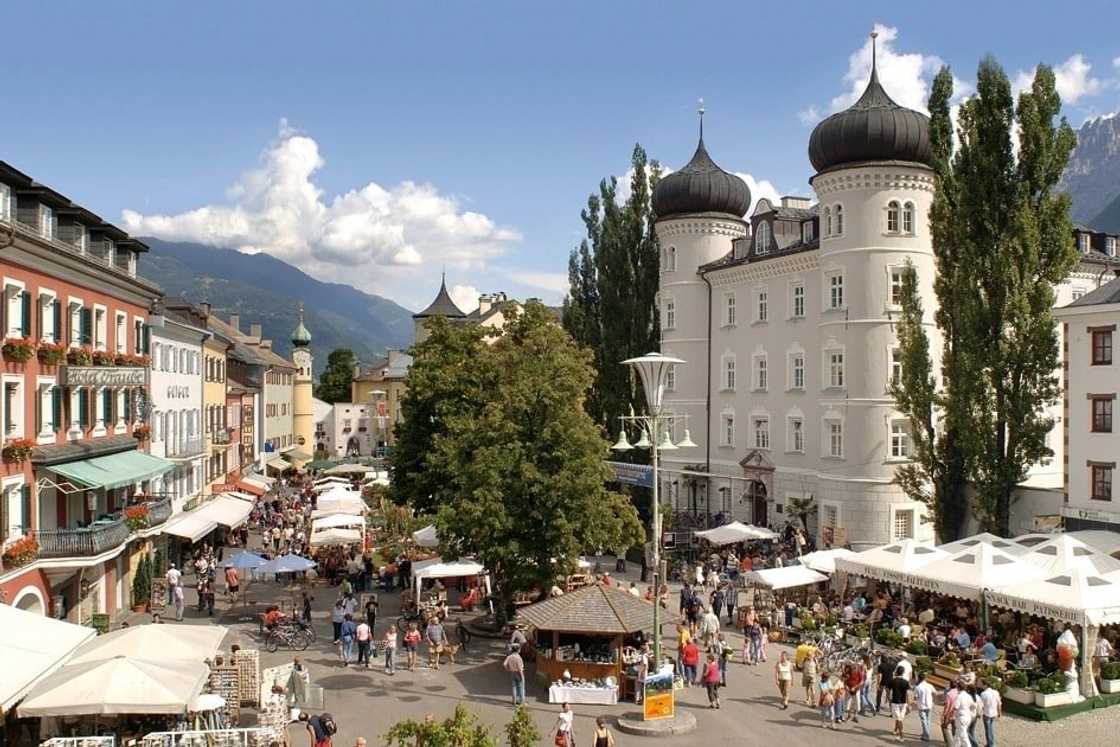
Source: UGC
It is found in the Drava valley in the Tyrol state Lienz covers an area of 15.94 sq.km and had 12,046 people as at 1 January 2018. Attractions here include the Bruck Castle, which is the landmark of Lienz. It has a medieval fortress and a museum there is also the Galitzen Gorge waterfall Trail and the Pustertal high mountain road. Recreational activities here include cycling, skiing and cross-country skiing.
57. Hollabrunn

Source: UGC
It is found in the lower Austrian state on Gollersbach River. Hollabrunn covers an area of 152.38 sq.km and has a population of 11, 736 as at 1 January 2016. This region has a lot to offer with many tourist attraction including Josef Hyrtl Denkmal, Koliskowarte, and Laurenzibrundl.there are also historic sites such as Alter Hofmuhle Hollarbrunn, specialty museums such as Koller’s Oldtimermuseum as well as churches and cathedrals such as Pfarrkirche Ravelsbach.
58. Enns

Source: UGC
It is found in the Upper Austrian state on the River Enns. The River forms a border with the state of Lower Austria. It has an area of 22. 97 sq.km and a population of 11,736 as at 14th June 2016. Its landmark is the Town Tower and was erected during the reign of Macmillan II.
59. Rankweil

Source: UGC
It is the 8th largest town in Vorarlberg covering an area of 21.87 sq.km and having 11,731 inhabitants as at 1 January 2016. It is located in the Upper Rhine Valley and is home to the largest river, River Frutz. It is known for its Basilica. Other sites include Pilgrimage church which dates to 700 and began as a fortress, St. Peter’s church, Open-air museum, Sigmund Nachbauer Memorial, Town Hall wine production at Liebfrauenberg, Museum of printmaking and Natalie Beer Museum. Sports played here include soccer, tennis, golf, ice rink, fitness trail, and sports shooters court. There are 125 clubs active in sports, culture, music, religion and family. Events include autumn market, annual fare and Rainkweil summer, a holiday program with more than 40 events
60. Bad Voslau

Source: UGC
It is a spa town in upper Austria covering 36.74 sq.km with a population of 11,700 as at 1 January 2016. Fun activities here include visiting the Thermalbad Voslau spas, Kurpark and Doblhoff Park, Casino Baden. Historic sites include Stadtmuseum Bad Voslau and Weingut and Heuriger Husar.
61. Brunn am Gebirge
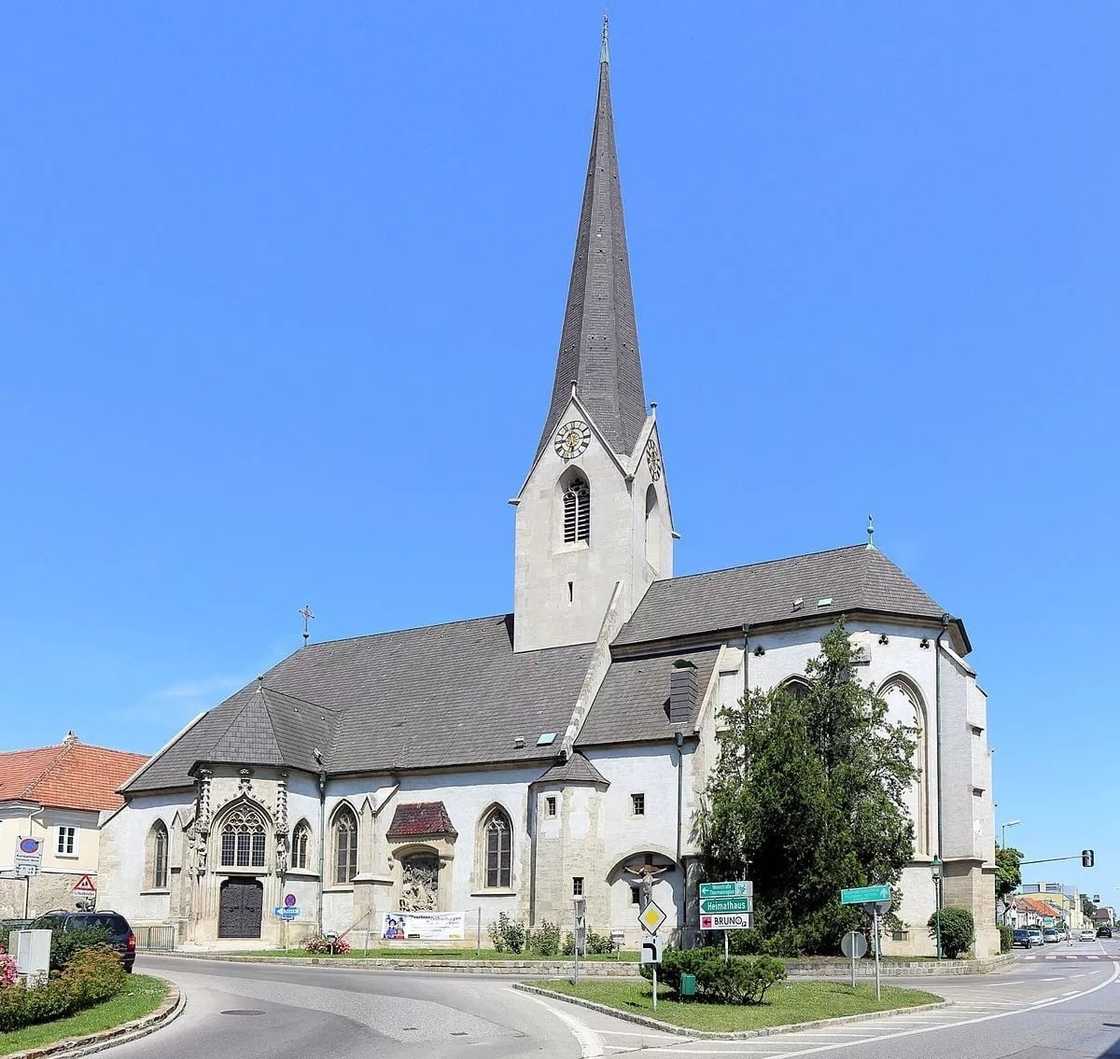
Source: UGC
Brunn am Gebirge is found in the state of Lower Austria and covers an area of 7.26 sq.km with a population of 11,686 as at 1 January 2016. It has a great cultural background, organizing the International piano blues and Boogie Woogie festival where many artists performed.
62. Ried am Innkreis
Ried am Innkreis is found in Upper Austria, west of Linz and North of Salzburg. It has an area of 6.77 sq.km and a population of 11,672 as at 1 January 2016. The Schwabenthaler are found here. The son of Scwabenthaler made the high altar and sculpture of the Group on the Mount of Olives. Several sculptures of the family are preserved in Upper Austrian churches and in the folklore museum. There are many churches and monasteries including Old Catholic Christ church and Methodist church. In sports, the Ried football soccer club. SV Ried has been sucessful at national level. It is currently playing in the Bundesliga 19th season.
63. Waidhofen

Source: UGC
Waidhofen is found in the Lower Austrian state and had a population of 11,366 as at 1 January 2016. It covers an area of 131.52 sq.km. It has many site including medieval houses and courtyards in Innenstadt old city, Stadtpfarrkirche, one of the largest and most historic churches, Rothschildschloss castle, Stadtturm city tower, Ybbs tower and city gate and Schwarzbachviadukt Bridge.
64. Mistelbach

Source: UGC
Mistelbach is found in Northern Austria, 40km North East of Vienna.it has population of 11,314 as at 1 January 2016, covering an area of 131.38 sq.km. Sites include the Gothiuc church built with a gothic Madonna from sandstone, Baroque castle, Town Hall, Museum center Mistelbach which includes Hermann Nitsch museum, an artist famous for his unconventional style and his performance art. It is also popular for Vienna style coffee houses which has become the city’s mode of life.
65. Knittelfeld

Source: UGC
Knittelfeld is located on the banks of Mur River in Styria state. It had a total area of 4.53 sq.km and a population of 11,301 as at 1 January 2016. It is known for the Knittesfeld Putsch, a party meeting of the Freedom Party which resulted in Austrian elections in 2002.
66. Gotzis

Source: UGC
Gotzis is found in Vorarlberg state, covering an area of 14.64 sq.km and a population of 11,287 as at 1 January 2016. Gotzis is well known for its annual Hypo-meeting where leading heptathletes and decathletes meet in Mosle Stadium.
67. Trofaiach

Source: UGC
It is found in the Syrian state. It covers an area of 143.25 sq.km and had a population of 11,229 as at 1 January 2016. It is the site of a camp of displaced persons, victims of WW2. The city is not short of attractions either, with plenty of specialty, historic, and science museums such as Traktormueum Eberhard, Montanunversitaet Leoben Werksfurhrung Voest Alpine Donawitz. Churches and cathedrals including Gustav –Adolf- Kirche and Evangelische Pfarrgemeinde A.B. Leoben. There are also monuments and statues such as Barbarastatue and Oppenheim Skulptur.
68. Ganserndorf

Source: UGC
It is found in Lower Austria, North East of Vienna. It has an area of 30.556 sq.km and a population of 11,021 as at 1 January 2016. Attractions include the Landscapepark used asa a recreational area, Kellergasse which has beautiful sites such as vineyards and baroque palaces as well as museums, the fascinating Central Europe floodplains and Town Hall. It is well known for its summer events including art gallery and live music programs.
69. Zwettl

Source: UGC
It is found in Lower Austria at the confluence of Kamp and Zwettl rivers. It covers an area of 256.07 sq.km and has a population of 11,005 as at 1 January 2016. The landmarks here include Stift Zwettl, a beautiful historic monastery and Burgruine Lichtenfels, a romantic historical old castle within the lake where one can make a walk or visit the castle. There are also sits for factory and eco tours. Specialty museums include Stadtmuseum Zwettl and Schnapsglasmuseum. Schloss Waldreichs is a beautiful castle in Zwettl.
70. Volkermarkt

Source: UGC
It is located in the Drava valley, East of Klagenfurt in Carinthia state. It has a total area of 137.33 sq.km and a population of 10,949 as at 1 January 2018. Tourism is big here due to access to many lakes and mountains, attracting about 20000 tourists per year. Hiking, fishing and watersports are the main recreational activities here. Sites and attractions are limited but include the pretty Market Square, Parish church of Pfarrkirche St. Ruprecht. There is also the ruined castle of Burgruine Hamburg just to mention but a few.
71. Sankt Johann in Pongao

Source: UGC
It is found in the state of Salzburg in the Salzach valley. It has a total area of 70 sq.km and had a total of 10, 945 people as at 1 January 2016. There are amazing sites worth seeing here including historical sites, cultural attractions as well as recreational facilities. These include Betterpark Alpendorf snow park, Alpendorf Bergbahnen for skiing and snowboarding, tourist attractions such Fortress Hohensalzburg, Untersberg and Salzburg cathedral.
72. Gerasdorf bei Wien

Source: UGC
It is found in Lower Austrian state, in the northern valley of Vienna, with a population of 10,782 as at 1 January 2016 and an area of 35.24 sq.km. Here you can visit nature and wildlife areas such as Laizner Tiergarten, Donaupark, Historic center of Vienna with historic sites and historic walking areas, gift and specialty shops such as G3 shopping resort, the Danube Tower, Imperial palace and many more.
73. Ebreichsdorf

Source: UGC
It is found in the Lower Austrian state, covering an area of 43.22 sq.km and had a population of 10, 645 as at 1 January 2016. Sites here include the Glass Castle, Fontana Golf club, Reitclub Magna Racino, Kurpark, Dodlhoff Park, Casino Baden just to mention a few.
74. Bischofshofen

Source: UGC
Bischofshofen is found in Salzburg state in the valley of the Salzach River, with an area of 49.62 sq.km and a population of 10,540 as at 1 January 2018. It is a good base for hiking and skiing Final competition for Four Hills Tournament, a ski jumping tournament, are held here annually. There are a couple of sites worth noting here for example the town museum which has over 5000 years of Bischofshofen history. Other sights and attractions include the Museum of Am Kastenturm, Parish church, Buchbergkircerl chapel, Gainfeld waterfalls and the ruined castle of Ruine Pongowe.
75. Groß-Enzersdorf
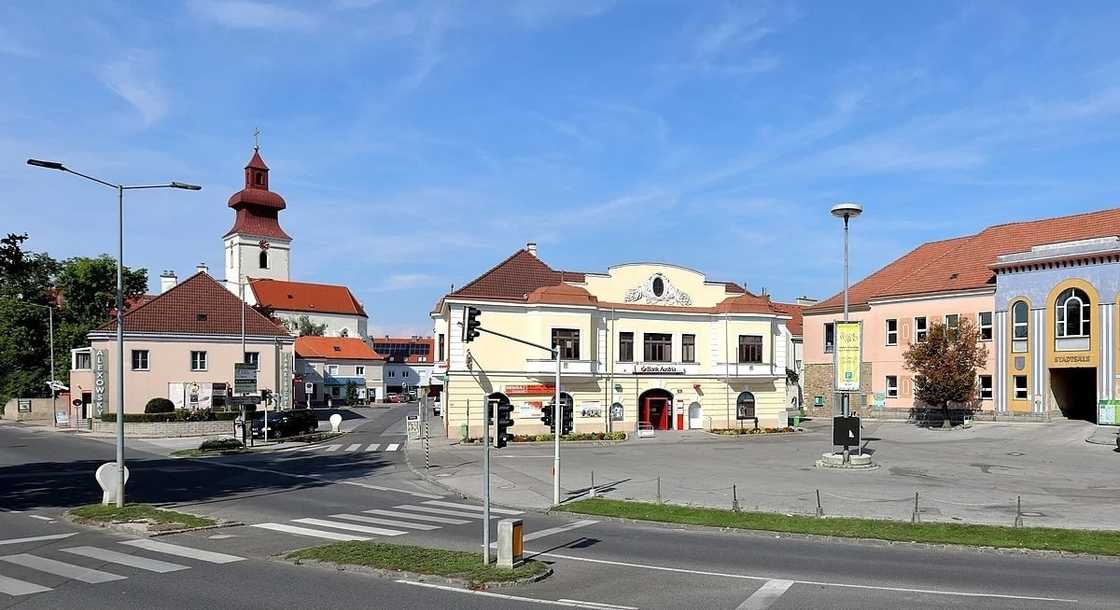
Source: UGC
Groß-Enzersdorf is found in the lower Austrian state, East of Vienna and North of Danube River. It has a total area of 83.91 sq.km and a population of 10,464 as of 1 Januatry 2016. It has a tennis team which plays in Bundesliga 2 as well as a soccer team. Famous buildings its defensive wall, Parish church with Romanesque, Gothic and Baroque styles and the city hall. It also has a drive-in theatre and a Sunday market known as Flohmarkt.
76. Seekirchen am Wallersee

Source: UGC
Seekirchen am Wallersee is found in the state of Salzburg, next to the picturesque Wallersee, with about 10,521 people within an area of 50.27 sq.km. It is an idyllic town on the lake with traditional Inns and coffee houses for all to enjoy. Recreational facilities in summer include swimming, surfing, sailing, running, horse riding and more.in winter, one can enjoy winter hikes and walks through the snow covered nature.
77. Sankt Andra

Source: UGC
Sankt Andra is a city in Carinthia named after St. Andrew. It had a population of 10,061 as at January 2016 and an area of 113.5 sq.km. Its main landmark is the former Sankt Andra cathedral. It also has several historic sites including Radovljica old town, Landscron castle and outdoor museum Kolovrat to name a few.
The list of cities in Austria includes historic sites, architecture, diverse culture, arts and entertainment as well as breathtaking physiques where people can go on site seeing or to spend time with their loved ones in the summer or even winter. Austrian cities and states in Austria have a lot to offer both local and international tourists.
READ ALSO: List of big towns in Ghana 2018
Source: YEN.com.gh

